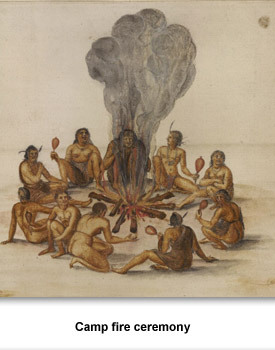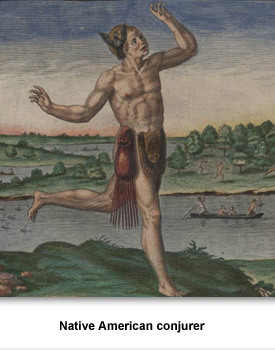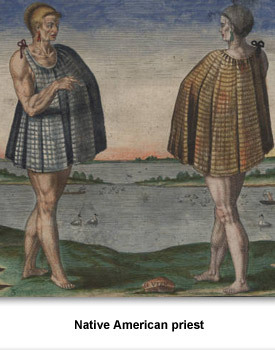Indians & Cultural Encounters
Religion
Most Tennessee Indians viewed the land as the “Middle World.” Land represented a balance between change and stability, and between the future and the past. It also separated the positive forces of the Upper World and the dangerous forces of the Underworld.
They believed animals were part of the Underworld, while plants were part of the Upper World. People lived in between the various forces of nature that were visible in the landscape around them.
Southeastern Indians also gave special importance to the directions (north, south, east, and west) and to certain colors. Directions were linked with colors and elements, but not always in the same way.
Among the Cherokees, for instance, the color red was associated with the east, symbolizing blood, war, life, and success. Among the Creek the eastern color was white, symbolizing peace and warmth. Other important symbolic elements in Indian religion were birds, serpents, and fire. These were related to the sun and represented purity.
One of the most important rituals among the Cherokees was the Green Corn ceremony. In earlier times it was probably performed several times a year to give thanks for the abundance of the earth. By the 17thcentury, it was performed in the late summer when the corn crop would ripen.
This ceremony brought the people of several villages together. This gave family members a chance to reunite, and to arrange marriages and deal with clan business. It also gave political leaders a chance to meet and work out alliances and resolve disputes.
But most importantly, it was a chance to renew the peoples’ relationship to the spiritual world, especially in the form of the sacred fire. This fire was kindled at the height of the ceremony and used to start household fires for the coming year.
Picture Credits:
- Drawing of a camp fire ceremony. The Indians in the drawing are pictured waving rattles and singing. Originally drawn by John Whyte this picture was included in the book A Briefe and True Report of the New Found Land of Virginia by Thomas Hariot. Later the image was engraved by Theodor de Bry and reprinted in 1590. The Indians pictured belong to the Southern Algonquian group of Indians and are related to the Shawnee. Trustees of the British Museum.
- Double portrait engraving entitled, “Native American priest.” This picture shows two different images of a priest wearing a long shirt and standing in front of a coastal scene. Originally drawn by John Whyte this picture was included in the book A Briefe and True Report of the New Found Land of Virginia by Thomas Hariot. Later the image was engraved by Theodor de Bry in 1590. De Bry wanted to make Native Americans look more like Europeans, so he drew them with blonde hair and white skin. Although the drawing is not entirely accurate, it demonstrates how some Europeans did not understand or appreciate the ways in which Native Americans were different from them. The man pictured belongs to the Southern Algonquian group of Indians, who are related to the Shawnee. North Carolina Collection, University of North Carolina.
- Drawing of a Native American conjurer. A conjurer was believed to have magical powers. The man in the picture is shown running or dancing. Several other people are featured in the background engaged in hunting and fishing. Originally drawn by John Whyte this picture was included in the book A Briefe and True Report of the New Found Land of Virginia by Thomas Hariot. Later the image was engraved by Gijsbert van Veen and reprinted in 1590. Some artists wanted to make Native Americans look more like Europeans, so he drew them with blonde hair and white skin. Although the drawing is not entirely accurate, it demonstrates how some Europeans did not understand or appreciate the ways in which Native Americans were different from them. The man pictured belongs to the Southern Algonquian group of Indians and are related to the Shawnee. North Carolina Collection, University of North Carolina.
Indians & Cultural Encounters >> Indian Life >> How They Lived >> Religion



 Sponsored by: National Endowment for the Humanities
Sponsored by: National Endowment for the Humanities